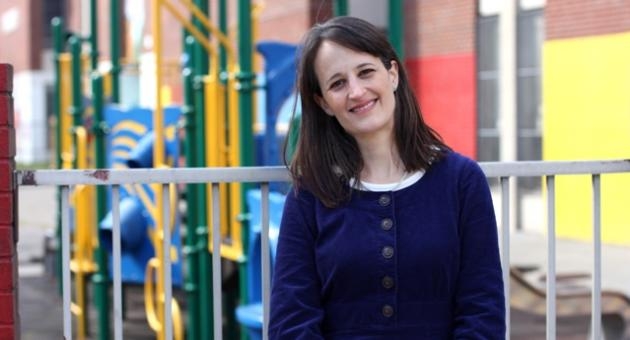Education professor’s new book examines consequences of Phila. schools initiative

A marketing campaign designed to attract families to Center City Philadelphia public schools had the consequence of privileging the middle class at the expense of the working class, further aggravating the inequality of schools in the School District of Philadelphia, according to Maia Bloomfield Cucchiara, an urban education professor at Temple University.
Cucchiara explores the impact of the 2004-07 Center City Schools Initiative (CCSI), which was part of a larger urban revitalization plan, in her new book, “Marketing Schools, Marketing Cities: Who Wins and Who Loses When Schools Become Urban Amenities,” published this month by The University of Chicago Press.
“The CCSI, which was designed to solve a really pressing social problem — middle class flight — ultimately positioned middle and upper-middle class parents as the constituency on which the city most depended,” said Cucchiara. “Parents became customers — and middle-class parents the most valuable customers.”
Over the last several decades, big cities across the country, including Chicago, Boston, Baltimore, Richmond, Milwaukee and San Francisco, have faced similar issues and tried similar solutions, but none were as explicitly targeted to the upper-middle class as Philadelphia’s, said Cucchiara. The CCSI was also unique in its pairing of a public and a private institution: the School District of Philadelphia and the Center City District.
In essence, the CCSI was “an effort to rebrand a subset of public schools as a way of distancing them from the rest of the stigmatized school district,” said Cucchiara. This entailed polishing the schools’ appearance, offering better customer service, creating a new administration for the Center City schools, giving admissions preference to those who lived in Center City and using sophisticated marketing such as websites, fliers, postcards and events to reach out to potential customers.
Cucchiara conducted a three-year, three-part investigation of CCSI. She first looked at the CCSI policy and how it came about given the social and economic history of the city. Next she examined the politics involved by talking with reporters, community leaders, legislators, activists and business leaders. Finally, she undertook an intensive ethnographic study of one of the CCSI Schools, referred to in the report by the pseudonym “Grant Elementary,” located in an affluent Center City neighborhood and considered one of the top schools in the district.
In Philadelphia, as in many other cities, the decline of the industrial economy, federal divestment from urban areas and the exodus of the middle class to the suburbs has created a set of unprecedented social and economic challenges, said Cucchiara. In response, urban leaders have turned to market models of urban revitalization, emphasizing the transformation of downtowns and attracting “knowledge workers” to bolster the local economy. The CCSI extended these strategies to the public schools.
In interviews, Cucchiara found that some politicians, activists, business leaders and others were angered by the funneling of resources and opportunities toward an already advantaged part of the city and the apparent exclusion of low-income students and communities.
“Yet for many others, such inequities were justified, given the potential of an increased middle-class presence to promote economic growth and school improvement,” she said.
For her intimate examination of Grant Elementary, Cucchiara visited regularly for two years, attending events and PTO meetings and talking with parents and educators.
“I found that the concerns and agendas of the working-class and poor parents differed from the middle and upper-middle class parents,” she said. For example, middle and upper-middle class parents invested most in transforming the school, while poor and working class parents’ focus was on supporting the school as it was.
She also discovered that although the middle and upper-middle-class parents were able to make positive changes, such as smaller kindergarten classes, the impact didn’t extend to other district schools, and may in fact have diverted resources from schools that needed more help.
Cucchiara doesn’t deny that middle class parents brought about positive changes. But she laments the way they were recruited.
“In a city with large numbers of poor residents, CCSI targeted middle and upper-middle-class families for special treatment and privileges,” said Cucchiara. “In a system with insufficient resources, it channeled energy into historically high-performing schools. In a system with thousands of students stuck in failing schools, the initiative made it more difficult for students from outside Center City to attain access to well-regarded downtown schools.”